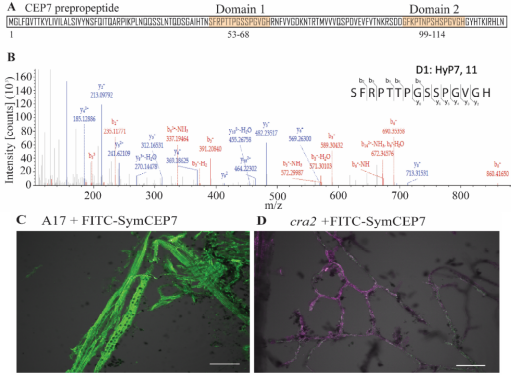A CEP signaling peptide regulating symbiotic nodules but not roots
The Medicago SymCEP7 hormone increases root nodule number via shoots without compromising lateral root number
Legumes acquire soil nutrients both through their nitrogen-fixing root nodules and lateral roots. To balance the costs and benefits of nodulation, legumes negatively control root nodule number by different hormonal pathways. How legumes simultaneously coordinate root nodule and lateral root development to procure nutrients remains however poorly understood. In Medicago (Medicago truncatula), a subset of C-TERMINALLY ENCODED PEPTIDE (CEP) hormones promotes nodule number but all CEP hormones tested to date also negatively regulate lateral root number. In a new collaborative study between the team SILEG at IPS2 and Michael Djordjevic (University of Canberra, Australia), published in Plant Physiology, we report using mass spectrometry that the Medicago CEP7 gene produces a mature peptide, SymCEP7, which promotes from the shoot, in a pM to nM concentration range, nodulation without compromising lateral root number. Fluorescence microscopy and expression analyses demonstrated that SymCEP7 activity requires the COMPACT ROOT ARCHITECTURE 2 (CRA2) receptor and activates the shoot-to-root systemic effector, miR2111. Shoot-applied SymCEP7 also promoted nodule number in White Clover (Trifolium repens) and Lotus (Lotus japonicus), which suggests that this biological function is evolutionarily conserved. We propose that SymCEP7 acts in the Medicago shoot to counterbalance the autoregulation pathways induced rapidly by rhizobia to enable nodulation without compromising lateral root growth, thus promoting the acquisition of nutrients other than nitrogen to support their growth.

06/02/2023
